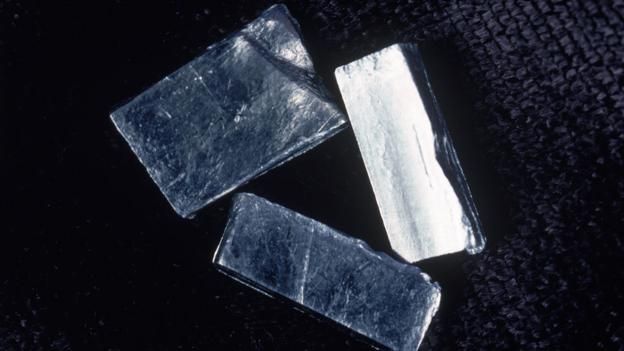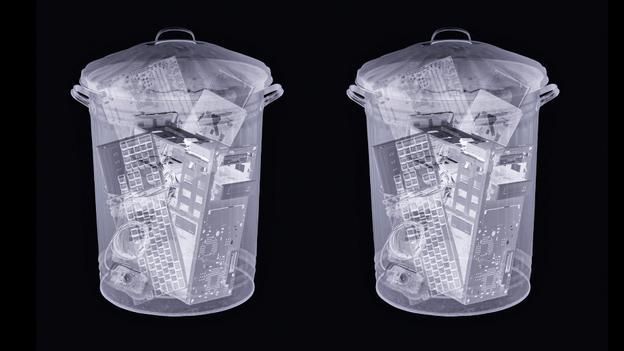世界上最稀缺的材料竟然是……
BBC雷切尔·努维尔(Rachel Nuwer)(2016年1月7日)

(图片来源:Thinkstock)
在全世界所有的自然资源中,哪一种将会率先“枯竭”?整个社会消耗的资源越多,关于重要的矿石和矿产不断减少的消息就越多。既然如此,似乎完全有理由认为某些资源可能即将枯竭。
然而,或许根本就不应该以这样的角度来看待这个问题。自然资源专家表示,现代生活中采用的很多材料根本不会“枯竭”。不幸的是,他们所描绘的短期景象也并不乐观。
我们最不可或缺的设备——例如智能手机、电脑和医疗设备——都要依赖种类多样的基本成分。光是手机里面就包含60至64种元素。“很多金属的使用量都很少,可能只有1毫克甚至更少。”化学家兼德国奥格斯堡大学资源战略主席阿明·雷勒(Armin Reller)说,“但对设备的功能而言却至关重要。”
这其中包括铜、铝和铁,但还有一些不太常见的材料,例如“稀土元素”,日本人称之为“科技的种子”。

平板电脑和智能手机都依赖一种名为稀土金属的材料(图片来源:Science Photo Library)
后一类材料受到各界的密切关注,因为它们是智能手机、混合动力汽车、风力涡轮、电脑和其他材料的关键原料。中国生产了全世界90%的稀土金属,该国表示,其稀土资源将在15至20年内枯竭。类似地,有人认为,倘若需求持续增加,铟矿资源大约仅需10年就会枯竭,铂矿只需15年,银矿只要20年。展望更遥远的未来,还有人认为,铝等其他资源可能会在80年左右的时间内开采完毕。
另有研究显示,按照在地壳中所占的比例以及对人类社会的重要程度来看,铑、金、铂、碲都是最稀有的元素。
但耶鲁大学林业和环境研究学院工业生态中心主任托马斯·格雷德尔(Thomas Graedel)认为,虽然这些数据令人震惊,但实际上,银、铂、铝或其他任何矿产资源都不可能真正枯竭。他表示,我们从未完全耗尽任何自然资源,今后肯定也不会。
供给与需求
事实上,不应该从资源是否枯竭的角度来看待这个问题。首先,根本不可能举出反例。科学家永远不敢肯定地说:“世界上已经没有银矿资源。”因为他们不可能彻底勘探地下的每一个角落。然而,更加实际的原因在于,等到我们真的担心某种矿产资源耗尽时,剩余的资源价格肯定会奇高无比,而厂商借此生产的任何产品都将无法创造利润。
因此,他们肯定已经转向替代资源——即使替代材料的效果不及原有材料。“随着供需关系的变化,价格也会进行调整,人们也会调整自己需要的产品和使用的方式。”美国地质调查局矿产资源项目协调员劳伦斯·梅纳特(Lawrence Meinert)说,“这意味着你永远不会用光所有资源,因为价格过高后就会迫使你停止使用。”
例如,20世纪80年代, 人们停用了冶炼铝矿石时所需的冰晶石,原因是剩余的储量太小,不足以支撑开采费用,因此只能使用人工合成的替代品。
事实上,根本不可能确定世界上最稀缺的究竟是哪种资源。梅纳特表示,在考虑稀缺性时,不应该以X元素或Y矿产在地球上的储量为标准,而是应该考虑这种资源的开采难度和市场的需求状况。因此,稀缺与否的关键在于可用性而不是实际的物理储量,而这种可用性也要受到很多因素的影响。

最快只要再过10年,我们可能就需要为智能手机中使用的铟寻找一种替代品。(图片来源:Science Photo Library)
首先,类似于铟(常见于电脑和智能手机显示屏中)这样的资源是其他采矿作业的副产品。全世界几乎所有的铟都来自锌矿,没有专门的铟矿,因为这种元素的储量很低,单独开采并不实际。
所以,如果锌的需求下滑——例如,由于汽车厂商最近逐步放弃钢板,转用铝制车身——就会对铟造成影响。“大自然存放矿产的地方很随意,从来不会考虑我们是否有足够的电或水来开采这些资源。”格雷德尔说。
在其他情况下,即使有专门针对某种资源的矿井,需求也可能超过供给。德语将某些资源称作Gewürzmetall(香料金属),因为它们就像肉桂或藏红花这种用量很少的香料一样,在电子设备的生产过程中仅占很小比例,但对于某些功能来说却至关重要。
钯被用作手机里的电容器,在这些设备的成分中仅占0.015%,但手机行业每年对这种稀有金属的使用量约为15吨。由于汽车、珠宝、牙科、医疗和电子行业也会用到钯,所以竞争最终会推高价格,而供给也会发生短缺。
政治同样会产生影响。多数稀土金属供应都源自中国。几年前,中国决定减少这类矿产资源的出口,导致稀土金属以及使用这种稀有金属制成的产品价格上涨。“世界其他地方并非没有稀土金属。”梅纳特说。例如,美国大约占到全球稀土储量的38%,但目前正在开采的只有南加州的一个稀土矿(之前曾经因为中国的竞争而关闭多年)。“从勘探到开采需要经过很长时间。”梅纳特说。
除了设定出口禁运政策的国家外,冲突也会对自然资源的可用性产生影响。例如,刚果民主共和国的战争会影响全世界的钶钽铁矿供应,这是一种用于生产电容的金属矿产。
无法替代
那么,我们是否应该担心矿产资源的减少呢?从历史上看,如果一种资源减少,人类就会找到具有同样效果的替代品。但不幸的是,在当今这个越发复杂的世界中,优秀的替代品已经很难找到。在最近的一项研究中,格雷德尔和他的同事试图为62种金属寻找最佳替代品。
他们发现,其中12种金属在主要用途上都找不到替代品,而这62种金属中没有一种能够找到覆盖全部用途的替代品。“由于我们现在使用的几乎都是一长串材料中效果最好的,所以如果转用替代品,性能有可能会下降——电脑速度会变慢,发动机的效率也会降低,诸如此类。”格雷德尔说。
接下来几年,格雷德尔希望能更好地了解哪种金属可能会很快出现短缺。产品开发团队可以借此思考可能的替代品,并集中精力开发原材料供应更加可靠的设备。

美国多数废旧电子产品都会直接扔进垃圾箱,而没有进行回收利用(图片来源:Science Photo Library)
与此同时,如果消费者能够找到可靠的方式来回收利用二手电子产品,也能起到一定的帮助。2009年,美国公民的废旧电视和电脑回收率仅为25%,手机更是只有8%。
“我们花费了大量的时间和精力开采了金和铂,将其用于电子产品。但实际上却只是用了一次,根本不在乎它们废弃之后的去向。这实在是太可惜了。”格雷德尔说,“回收利用无法解决资源减少的问题,但肯定能起到一定的帮助。”
雷勒表示,倘若全世界都开始全力回收废旧电子产品,并结合新的技术来更加高效地勘探、开采和分享我们所需的资源,那些现代生活中不可或缺的材料就有可能沿用数代。“但这番期待似乎像梦一样飘渺无望。”他承认。
供需平衡的确会对我们产生影响,日常技术的价格和可用性所受的影响尤其明显。所以,尽管没有一种材料稀缺到即将彻底消失的程度,我们仍然应该担心,其中很多资源或许很快就将离我们远去。
(责编:友义)
What is the world’s scarcest material?
By Rachel Nuwer,7 January 2024
Of all the world’s materials, which one will “run out” first? The more we consume as a society, the more we hear about how vital ores and minerals are dwindling, so it seems logical to assume that a few may be about to disappear.
Yet that may be entirely the wrong way of looking at the problem. According to natural resources experts, many of the materials we rely upon in modern life won’t “run out” at all. Unfortunately, the scenario they paint about what will happen instead in the near future is hardly rosy either.
Some of our most cherished devices – smartphones, computers and medical equipment, for instance – rely on a rich list of elemental ingredients. Mobile phones alone contain a whopping 60 to 64 elements. “Many of these metals are present in only minute amounts, a milligramme or less,” says Armin Reller, a chemist and the chair of resource strategy at Augsburg University in Germany. “But they are very important for the function of the device.”
This includes things like copper, aluminum and iron, but also less well-known materials, like the “rare earth elements”, what the Japanese refer to as “the seeds of technology”.
The latter class of materials has come under particular scrutiny because they’re a vital ingredient in smartphones, hybrid cars, wind turbines, computers and more. China – which produces around 90% of the world’s rare earth metals – claims that its mines might run dry in just 15-20 years. Likewise, if demand continues for indium, some say it will be gone in about 10 years; platinum in 15 years; and silver in 20 years. Looking farther into the future, other sources claim that things like aluminum might run dry in about 80 years.
Other studies indicate that rhodium, followed by gold, platinum and tellurium, are some of the rarest elements in terms of their percentage in the planet’s crust and their importance to society.
As startling as these figures sound, however, the complete loss of silver, platinum, aluminum or any other mineral resource will likely never come to pass, according to Thomas Graedel, director of the Center for Industrial Ecology at the Yale School of Forestry and Environmental Studies. We have never completely run out of a natural resource, he says, and we almost certainly never will.
Supply and demand
Thinking in terms of “running out” is not the right way to approach this problem. For starters, it’s impossible to prove a negative. Scientists could never definitively say “The world has no more silver reserves” without checking every last subterranean nook and cranny on the planet. The more practical reason, however, is that by the time we reached the point that running out is even a consideration, the price tag for those last remnants would be prohibitively expensive, and manufacturers would not be able to turn a profit on any products made from them. They already would have moved on to a substitute resource – even an inferior one. “As supply and demand change, prices change and people adapt what they need and how they use it,” says Lawrence Meinert, program coordinator of the US Geological Survey’s Mineral Resources Program. “This means that you can never consume everything because the price gets so high you stop using it.”
In the 1980s, mining for cryolite – used in processing aluminum ore – stopped because remaining reserves were too small to justify the expense of mining. We simply moved on to using a synthetic substitute.
It’s not really possible to put a label on what the world’s rarest resource is, either. Instead of thinking in terms of how many tonnes of element X or mineral Y are left in the earth, Meinert says, rarity depends on how easy it is to get our hands on that resource, and also on the market’s demand for that commodity. Rarity, thus, becomes more a question of availability than of actual physical reserves, and that availability can be influenced by a variety of forces.
For starters, some resources such as indium – found in computer and smartphone display screens – are byproducts of other mining operations. Almost all of the world’s indium comes from zinc mines; there are no dedicated indium mines, because it occurs in such small amounts mining for it is impractical. So if demand for zinc declines – say, because car manufacturers switch from steel to aluminum bodies, as they have been doing recently – then this would have an impact on indium. “Nature puts deposits where it feels like, without worrying about whether we have the energy or water handy to deal with it,” says Graedel.
In other cases, demand might surpass supply, even if there are dedicated mines for the material. Certain resources are sometimes referred to by the German term Gewürzmetall – “spice metal – because, like a dash of cinnamon or saffron tying a dish’s flavour together, these materials compose only a small proportion of an electronic device’s makeup but are essential for that device to function. Palladium, which is used as a capacitor in cell phones, makes up just 0.015% of those devices’ composition, but the cell phone industry goes through about 15 tonnes of that rare metal each year. Given that palladium is also used by the automotive, jewellery, dental, health and electronics industries, eventually, competition could drive up prices, and supply could fall short.
Politics can come into play, too. Most of the rare-earth-metals supply comes from mines in China. Several years ago, China decided to cut down on its export of those elements. As a result, the price of rare earth metals – and the goods they are used to make – has increased. “It’s not that the rest of the world does not have rare earth metals,” Meinert says. The US, for example, holds around 38% of the world’s deposits, but only one mine in southern California (which was closed for several years due to competition from China) is currently producing them. “It takes a long time to put a mine into production,” Meinert says.
In addition to countries setting their own embargoes on exports, conflicts have an impact on resource availability. Fighting in the Democratic Republic of the Congo could affect the world’s supply of coltan, for example, a metallic ore used to make capacitors.
No substitute
So should we worry about dwindling resources? Historically, the argument that, if one element or another runs dry, the world will find alternatives has worked pretty well. Unfortunately, however, in today’s increasingly complex world, good substitutes are hard to come by. In a recent study, Graedel and his colleagues tried to identify the best substitutes for 62 metals. Twelve of those metals, they found, had no substitute at all for their major uses, and none of the 62 they studied had a substitute available to cover all of their uses. “Because we chose what’s almost always the best from a long list of materials, performance is likely to decrease – computers will get slower, engines will be less efficient and so on – if we start making substitutions,” Graedel says.
Within the next several years Graedel hopes to have a better idea of which metals might soon be in short supply. Product development teams could begin thinking of possible substitutes, and to focus on developing devices using materials with more reliable supplies.
In the meantime, it would help if consumers found responsible ways of recycling their used electronics. In 2009, US citizens recycled just 25% of their used TVs and computers, while as little as 8% of mobile phones were recycled. “It’s really a tragedy that we spend all this time and effort getting gold and platinum and other things we use in our electronics, but then we use them once and don’t worry about what happens to them after that,” Graedel says. “Recycling won’t solve the problem [of scarcity], but it certainly would help.”
If the world began recycling in full force and combined those efforts with new technologies for efficiently finding, extracting and sharing the resources we need, it could be possible that the materials integral to modern life will last for generations to come, Reller says. “But that hope might be a little bit dream-like,” he admits.
The balance of supply and demand does affect us, especially when it comes to the price and availability of the technology in our lives. So while no material is so scarce that it is about to disappear entirely – we should worry that many could soon become out of reach.